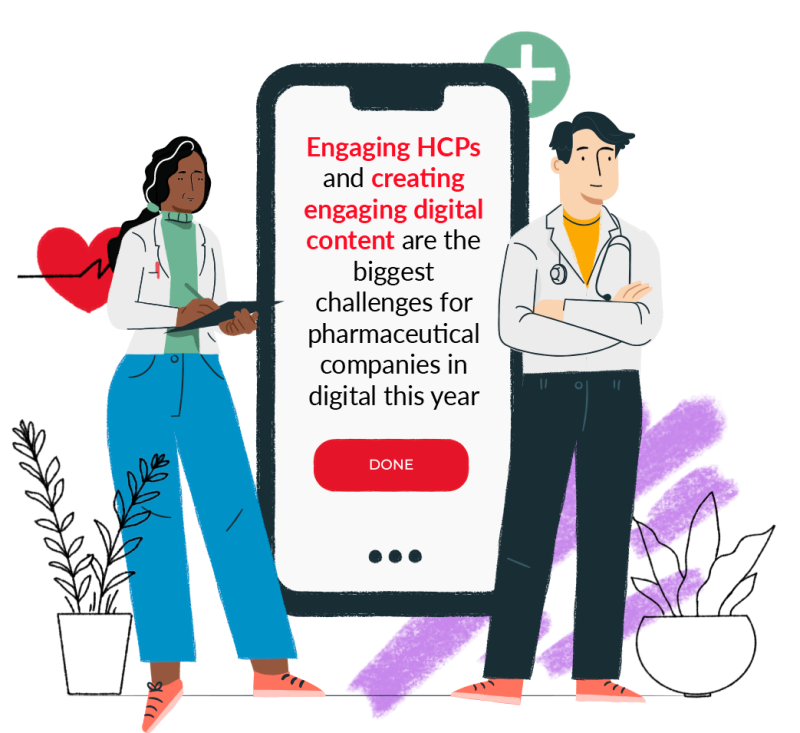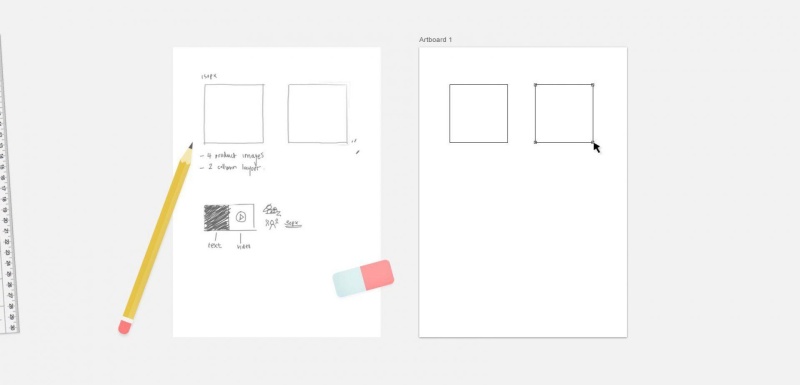
A first-hand perspective on the changing role of medical reps in the digital era

- Pharmaceutical
The role of the medical representative has long been a crucial one for pharmaceutical companies — they are the face of their brands and the conduit between healthcare professionals (HCPs) and pharma businesses, overseeing the exchange of important information and the development of strong relationships.
Over recent years, the role of the medical rep and their relationship with HCPs has changed drastically and been further accelerated by the pandemic. Gone are the days of relaxed face-to-face lunch appointments and overseas conferences. The HCPs of today — in the UK at least — have increasingly heavy workloads and less free time to dedicate to rep appointments. Digital platforms and new technologies have eradicated the need for physical brochures and more recently, face-to-face meetings.
But where does this leave the medical rep? We spoke to Graphite Account Manager, Navdeep — who was until recently a medical rep — to get a first-hand account of the changing rep-HCP relationship.
Meet Navdeep
We were delighted to recently welcome Navdeep Kalsi to the Graphite team where she will be taking on the role of Account Manager and working closely with our high-profile clients to scope and deliver world-class digital products.
Navdeep started her career in the pharmaceutical industry 20 years ago and has been employed by a number of global companies including MSD, Lilly, Pfizer, AstraZeneca, Johnson & Johnson, and GSK. She worked in HCP-facing roles under various job titles — Medical Representative, Account Manager, Network Sales Specialist, or Territory Business Manager. Navdeep was primarily responsible for maintaining relationships with GPs and other healthcare professionals within the southeast of the UK, covering Essex and parts of Kent.
With her extensive experience in HCP-facing roles, Navdeep has an in-depth understanding of the nature of the HCP-rep relationship and the priorities, preferences, and concerns of HCPs today. We spoke with Navdeep to get a first-hand perspective on the changing nature of the HCP relationship in recent years.
The historical HCP-rep relationship
When Navdeep started her career in the pharmaceutical industry, there were large but close-knit teams of medical reps working collaboratively across territories — she was one of 12 covering Essex who would communicate and meet up regularly.
The role of the medical rep was less aligned with account management, and more focused on the ‘number-crunching’. Typical targets were things such as going to see a certain number of GPs in a given time or trying to arrange a set number of meetings.
Historically, HCPs had more time on their hands to dedicate to meetings with representatives. Navdeep spoke of occasions where she’d be sat in a waiting room with 5 or 6 other reps and the GP would make time to sit through meetings of a decent length with all of them.
“Back in the day, you could just knock on a GP surgery’s door and go and see them!”
Medical reps had higher budgets to work with in the past, particularly under the big global brands. There was plenty of funding available to host educational meetings, lunch meetings, and events, and GPs were happy to come out to them.
The nature of the HCP-rep relationship was more glamorous in times gone by, with meetings and business lunches often taking place in high-end restaurants and hotels. There would be annual conferences overseas in places such as Tenerife or Florida and UK-based events accompanied by glitzy gala dinners and awards ceremonies.
A changing relationship
Over time, teams of medical representatives have gotten smaller with lots of restructuring happening in the last decade in particular. Gone were the days of 12+ people covering one territory — in a recent role, Navdeep was solely responsible for covering the whole of Essex and parts of Kent, which is now the norm across organisations.
As GPs and other HCPs became increasingly time-poor due to increased workloads and reduced budgets, flexibility in terms of obtaining meetings and appointments dissipated.
“Sometimes my diary would be crazy, but I had to say yes to all appointments, otherwise I’d miss out on the opportunity.”
Over time, work has become more stressful for HCPs. They have to stick to budgets that are getting increasingly tight and are sometimes under pressure to meet budget targets by prescribing the most cost-effective drugs. They also have a lot of involvement with the local CCG and medicines management on a day-to-day basis which can be time-consuming.
Nowadays, more and more pharmaceutical companies will fill medical rep roles via a contract agency and are reluctant to take anyone on their full-time roster.
What tools were being used?
Historically, reps were reliant on printed sales aids, brochures, and leaflets as the sources of information that their face-to-face meetings would be centred around. Navdeep would carry 5 or 6 leaflets for each product, each with varying levels of detail. There would also be lots of promotional ‘freebies’ handed out — pens, post-it notes, first aid kits, winter car kits, mugs, clocks, etc.
Around 10 years ago, the industry moved to a combination of iPads or other tablets, alongside some paper leaflets to leave behind for HCPs. Reps would talk through pre-prepared slide decks. Branded freebies were abandoned in most instances, “there were concerns from the regulatory bodies that if a pen had the name of a particular drug on it for example, and a GP was using that pen, they might then be inclined to use this drug as the name is already in their mind.”
In recent years, the vast majority of pharma companies decided to go completely paperless, structuring meetings around walk-throughs of HCP sites or presentations via video conferencing tools. In place of leaving physical flyers and brochures with detailed product information, medical reps will now follow up their meetings with links to online resources or email attachments for HCPs to digest in their own time, creating a more convenient and always-on experience for the busy HCPs. It's now more crucial than ever that pharma companies have optimised, easy-to-use, and engaging HCP-facing websites and digital platforms.
How did HCPs react to the increased role of digital tools and platforms?
Navdeep recalls that HCPs were generally receptive to these technological advancements and format changes. It may take some time to get HCPs on board — they are busy people who don’t want to spend time getting to grips with complicated sites and platforms that they find difficult to navigate — but if you had a strong digital product and took the time to explain the benefits, people would come around.
Sometimes, the introduction of a simple-to-use tool on an HCP site could be used as a means of generating initial interest and getting doctors and nurses onto the site in the first place, from which point they could explore and read around further. An example that Navdeep recalls was an option to quickly order inhalers online to be sent directly to the surgery. This made the life of the HCP easier and made them more inclined to view the other content on the site.
The impact of the pandemic
It’s no secret that medical professionals have been hit hard by the events of the last 18 months, and this in turn has had a huge impact on the HCP-rep relationship.
Many GPs found working from home during the lockdowns incredibly difficult and stressful. Trying to make an accurate diagnosis via video call was a new process that left many HCPs doubting themselves. HCPs had to make judgement calls without physically seeing patients in a very high-pressure environment where the NHS was under a huge amount of pressure from the sheer volume of patient interactions.
For the first 2 – 3 months, reps were unable to speak with anyone and all the usual meetings and events understandably ground to a halt. Navdeep recalls:
“You could hear in their voices just how exhausted they were and some would even express how they were finding it difficult to cope and function.”
Where did this leave reps?
An empathetic approach was needed in this unprecedented situation. Conversations moved from being lead by drugs and products to being centred around a simple question — "how are you?".
“Sometimes our HCPs would really open up which was nice — they just wanted to talk to someone”, Navdeep remembers. In the long-term, this built trust in the relationship and sometimes lead to more fruitful conversations about products later down the line.
All appointments were moved online, using platforms such as MS Teams, Zoom, and Google Hangouts. HCPs and reps are now used to and feel comfortable with these new ways of working.
What type of content do HCPs want to engage with?
Most importantly — pharma companies should keep everything top line and easy to digest. When working with busy HCPs, simplicity really is key. Digital pharma teams and reps should utilise bullet points and subheadings to effectively signpost their most important information, with options to click to reveal more detail where desired.
Creating modular and reusable content can save a lot of time, but should not be done without considering the context of the HCP and why they are likely to be reading the content can help to ensure a focus on helping the HCP complete the task at hand.
Educational content and training materials are more valuable than ever with a reduction of in-person meetings and events. High-quality training and education content should be at the core of any new digital offering for HCPs as this content when done well, provides high value to the HCP user.
Another key thing to remember, Navdeep advises, is to always ask the HCP what they want to know.
“I used to start every session by saying ‘tell me what it is you want to know’ and then structure each meeting around that”.
HCPs are an incredibly honest group of people and will be upfront about their knowledge gaps or any lack of understanding. By starting the conversation with a focus on educating and building knowledge, the later commercial side of the conversation feels more natural and flowing.
Gathering feedback from HCPs
In Navdeep’s experience, digital and product teams within pharma companies were generally open to implementing changes and taking on board suggestions for improvements to their digital products. A feature of her role in the past was to regularly gather feedback from her team of reps as well as directly from HCPs about the content and features that were considered crucial, useful, nice-to-know, and in some cases unnecessary or not adding value to the overall customer experience.
At Graphite, the importance of user research for customer experience is something we are passionate about and continuously highlighting to our pharma clients. Whilst it’s great to hear that HCP feedback is valued, we’d love to see more extensive UX research taking place during the product development and prototyping stages, leading to better digital products that are more closely aligned to the needs of the customer.
Without a doubt, the COVID-19 pandemic has accelerated a change to the role of the rep in the HCP and pharma relationship. This change has been gradually progressing for well over a decade, but with HCPs busier than they have ever been, and more likely to decline an in-person visit, the challenge of keeping and enhancing the value that reps bring to that relationship can no longer be ignored by pharma companies.
Look out for our follow-up blog where we’ll be looking at the future of the pharmaceutical rep and their relationship with healthcare professionals through different perspectives from key industry figures.

